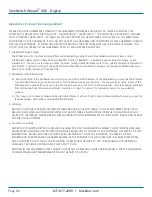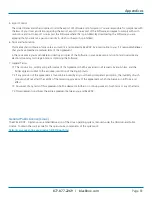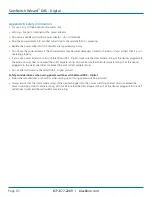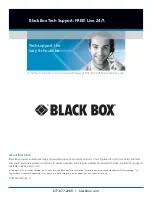
ServSwitch Wizard
™
DXS - Digital
877-877-2269 | blackbox.com
Page 74
Appendix F. An introduction to IPv6
During the initial design of the Internet, 4.3 billion seemed like an impossibly large number of device addresses, possibly more
than would ever be needed. It took nearly forty years, but finally the last remaining vacant address blocks within the current
Internet Protocol scheme (called
IPv4
) were assigned in February 2011.
The Internet Protocol is a crucial element of Internet operation and the eventual exhaustion of unique addresses was predicted
and acted upon many years ago. The replacement for IPv4 is known as
IPv6
and was defined in December 1998. Since then its
uptake has been slow (reportedly used for less than 1% of Internet traffic in 2008) although this will increase rapidly as places
within the incumbent system are exhausted.
Vastly increased address space
The most notable feature of IPv6 is the size of its address space, put simply: It’s massive. By using 128 bits to define each IPv6
address (rather than the 32 bits used in IPv4), there are now 340 x 10
36
unique addresses (that’s 340 trillion trillion trillion or as it
is correctly known, 340 undecillion).
The larger address size of IPv6 requires a different manner of notation. Instead of the four decimal numbers separated by dots
used for IPv4 (e.g. 192.168.0.1), IPv6 addresses consist of eight groups of four hexadecimal digits that are separated by colons
(e.g.
2002:00a2:67be:0000:0000:0e82:8723:a144
) – each group of four digits represents 16 bits of the address. By necessity,
IPv6 addresses are quite long and so there are a couple of techniques to help reduce this in certain cases:
• Where a group has one or more leading zeroes, these can be omitted. In the above example
00a2
and
0e82
can be written
a2
and
e82
, respectively.
• Where one or more consecutive groups consist solely of zeroes, they can be replaced with a double colon (
::
). In the above
example, the fourth and fifth groups could be replaced with the double colon, so that the whole line could be reduced to:
2002:a2:67be
::
e82:8723:a144
. It is easy to return any such shortened address to the full version by replacing the double colons
with sufficient groups of zeroes until the total number of groups is returned to eight. For this to work it is essential that only
one set of consecutive zero groups within an address are replaced with a double colon.
Standard subnet size
Thanks to the new huge address space, IPv6 does not need to wring every last drop out of each address range and so it handles
address allocation in a different manner than its predecessor. Whereas IPv4 uses subnets of varying sizes (using the Subnet Mask
entry to define the size of each subnet), IPv6 subnets are (almost) all set to a standard size. A full 64 bits are used to define each
subnet, which means that every standard IPv6 subnet has use of an address space that is the square of the entire IPv4 address
space (that’s 1.8 x 10
19
addresses per subnet). In those subnets, all addresses are valid host locations; gone are special address
formats for particular uses, such as broadcast traffic. Also, now that all standard subnets are the same size, the subnet mask is
another item that is made redundant under IPv6.











































